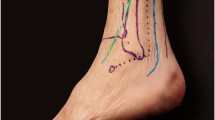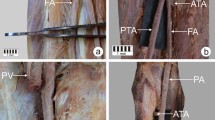Abstract
Purpose
This study aims to provide data, with the use of computed tomography angiography, regarding the level of bifurcation of the peroneal artery to the anterior perforating branch and the lateral calcaneal branch, in relation to the osseous anatomic structures of the tibial plafond, the medial malleolus and the lateral malleolus.
Methods
The study included patients who underwent diagnostic computed tomography angiography of the lower extremities. Measurements were performed in two-dimensional reconstructions and included the perpendicular distance from peroneal artery bifurcation into anterior perforating branch and lateral calcaneal branch to the lowest level of tibial plafond (D1), medial malleolus (D2) and lateral malleolus (D3). The distances were also normalized to the length of the tibia.
Results
Sixty patients and a total of 115 limbs were enrolled in this study. The mean distance ± standard deviation from peroneal artery bifurcation to tibial plafond (D1) was 4.33 ± 1.12 cm (normalized 0.12 ± 0.03) (range 2.54–8.26 cm), to medial malleolus (D2) was 5.53 ± 1.18 cm (normalized 0.16 ± 0.03) (range 3.27–9.5 cm) and to lateral malleolus (D3) was 6.53 ± 1.17 cm (normalized 0.18 ± 0.03) (range 4.71–10.2 cm), respectively. There was no significant difference between right and left limb measurements (p > 0.05). Females presented lower, but not statistically significant (p > 0.05), D1, D2 and D3 measurements compared to males.
Conclusion
The bifurcation of the peroneal artery takes place at lower level compared to previously published studies and consequently extreme caution should be exercised when performing the posterolateral approach to the ankle. This study adds to the understanding of the relevant vascular anatomy of the region and assists in performing the posterolateral approach to the ankle with safety.



Similar content being viewed by others
Availability of data and materials
Available upon request.
References
Assal M, Dalmau-Pastor M, Ray A, Stern R (2017) How to get to the distal posterior tibial malleolus? A cadaveric anatomic study defining the access corridors through 3 different approaches. J Orthop Trauma 31:e127–e129. https://doi.org/10.1097/BOT.0000000000000774
Bartonicek J, Rammelt S, Tucek M (2017) Posterior malleolar fractures: changing concepts and recent developments. Foot Ankle Clin 22:125–145. https://doi.org/10.1016/j.fcl.2016.09.009
Basit H, Eovaldi BJ, Sharma S (2021) Anatomy, bony pelvis and lower limb, peroneal artery. StatPearls, Treasure Island
Basit H, Shah J, Siccardi MA (2021) Anatomy, bony pelvis and lower limb, foot peroneus brevis muscle. StatPearls, Treasure Island
Gaillard J, Bourcheix LM, Masquelet AC (2018) Perforators of the fibular artery and suprafascial network. Surg Radiol Anat 40:927–933. https://doi.org/10.1007/s00276-017-1927-7
Irwin TA, Lien J, Kadakia AR (2013) Posterior malleolus fracture. J Am Acad Orthop Surg 21:32–40. https://doi.org/10.5435/JAAOS-21-01-32
Kelikian AS (2011) Sarrafian’s anatomy of the foot and ankle descriptive, topographic functional. Lippincott Williams & Wilkinsm, Philadelphia
Ketz J, Sanders R (2012) Staged posterior tibial plating for the treatment of orthopaedic trauma association 43C2 and 43C3 tibial pilon fractures. J Orthop Trauma 26:341–347. https://doi.org/10.1097/BOT.0b013e318225881a
Kim D, Orron DE, Skillman JJ (1989) Surgical significance of popliteal arterial variants. A unified angiographic classification. Ann Surg 210:776–781. https://doi.org/10.1097/00000658-198912000-00014
Lidder S, Masterson S, Dreu M, Clement H, Grechenig S (2014) The risk of injury to the peroneal artery in the posterolateral approach to the distal tibia: a cadaver study. J Orthop Trauma 28:534–537. https://doi.org/10.1097/BOT.0000000000000089
Longo B, Sorotos M, Nicolotti M, Santanelli di Pompeo F (2014) Retrospective analysis of incidence of peroneal artery hypoplasia in 101 free fibula transfers and new classification of popliteal branch anomalies. Injury 45:394–398. https://doi.org/10.1016/j.injury.2013.09.027
Penera K, Manji K, Wedel M, Shofler D, Labovitz J (2014) Ankle syndesmotic fixation using two screws: risk of injury to the perforating branch of the peroneal artery. J Foot Ankle Surg 53:534–538. https://doi.org/10.1053/j.jfas.2014.04.006
Sandelin H, Tukiainen E, Ovaska M (2017) Amputation following internal fixation of an ankle fracture via the posterolateral approach—a case report. Acta Orthop 88:358–360. https://doi.org/10.1080/17453674.2016.1262679
Tornetta P 3rd, Ricci W, Nork S, Collinge C, Steen B (2011) The posterolateral approach to the tibia for displaced posterior malleolar injuries. J Orthop Trauma 25:123–126. https://doi.org/10.1097/BOT.0b013e3181e47d29
Wacker F, Lippert H, Pabst R (2018) Arterial variations in humans: key reference for radiologists and surgeons. Thiemme Publishers, Stuttgart
Funding
There was no funding for this work. It was not required.
Author information
Authors and Affiliations
Contributions
NG: prepared the manuscript draft and performed the CTA measurements. MK: prepared the manuscript draft and performed the CTA measurements. AK: performed a critical review of the manuscript and conceived the presented idea. GK: performed a critical review of the manuscript. BS: assisted in analysis of the results. THT: contributed to the design and implementation of the research, to the analysis of the results and to the writing of the manuscript.
Corresponding author
Ethics declarations
Conflict of interest
The authors declare that they have no conflict of interest.
Ethical approval
This was obtained from our Hospital Ethics Committee.
Consent to participate
Consent was obtained.
Consent to publish
Consent was obtained.
Additional information
Publisher's Note
Springer Nature remains neutral with regard to jurisdictional claims in published maps and institutional affiliations.
Rights and permissions
About this article
Cite this article
Galanakis, N., Klontzas, M.E., Karantanas, A. et al. The level of bifurcation of peroneal artery and its implications for posterolateral approach to the ankle: a CT angiography study. Surg Radiol Anat 43, 1697–1702 (2021). https://doi.org/10.1007/s00276-021-02800-y
Received:
Accepted:
Published:
Issue Date:
DOI: https://doi.org/10.1007/s00276-021-02800-y




